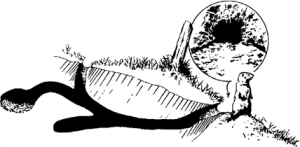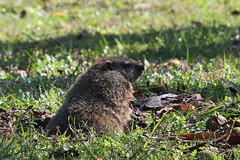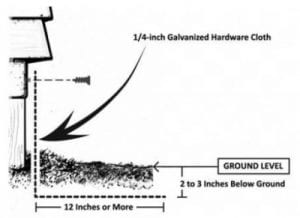“My enemies are worms, cool days, and most of all woodchucks.” – Henry David Thoreau
Thank you to guest blogger Paul D. Curtis, Department of Natural Resources and the Environment, Cornell University.
Woodchucks (Marmota monax) are large members of the squirrel family and are closely related to other species of marmots in North America. They usually are grizzled grayish brown from head to toe. Their compact, chunky body is supported by short strong legs. The forefeet have long, curved claws that are well adapted for digging burrows.

Woodchuck, aka Marmota monax, groundhog, whistle pig, and land beaver. Photo: mass.gov
Like other rodents, woodchucks have chisel‐like incisor teeth. Their eyes, ears, and nose are located toward the top of the head, allowing the animal to remain concealed in its burrow while checking for danger over the rim of the burrow opening.
Both sexes are similar in appearance, but males are slightly larger. Woodchucks weigh five to ten pounds, and the total length of their head and body averages 16 to 20 inches.
Biology and Behavior
Woodchucks breed in March and April. One litter of young (usually four) is produced each year, after a gestation period of about 32 days. Young are born blind and hairless, and weaned by late June or early July. Young woodchucks leave the den soon after they are weaned. The lifespan of a woodchuck is three to six years.
They enter true hibernation near the end of October or early November and continue until late February and March. Males usually come out of hibernation before females and sub‐adults, and may travel long distances in search of a mate. Woodchucks usually range 50 to 150 feet from their dens during the daytime.

They’re good climbers! Photo: Jack Lloyd
Woodchucks are primarily active during daylight. They sometimes bask in the sun during the warmest periods of the day and may doze on fence posts, stone walls, large rocks, or fallen logs close to the entrance of their burrow. Woodchucks are good climbers and are sometimes seen in lower tree branches.
They commonly construct burrows in fields and pastures, at the base of trees, and along fence rows, stone walls, roadsides, and building foundations. The burrow serves as home to the woodchuck for mating, weaning young, hibernating, and protection.

Schematic of a typical woodchuck den. Image: Prevention and Control of Wildlife Damage
A burrow or den system is used for several seasons and may be five feet deep, and 8 to 60 feet long. A woodchuck burrow has a large mound of excavated earth at the main entrance, called a porch. The main opening typically is 10 to 12 inches in diameter, and many burrows have two or more entrances. The secondary entrances are dug from below the ground, and do not have mounds of earth beside them, making them difficult to locate. These secondary entrances provide an escape near the den when pursued by predators. Young frequently occupy abandoned dens or burrows, as do rabbits, weasels, and other wildlife. New burrows that appear during late summer usually are dug by older woodchucks.
The Problem

Burrow openings aren’t necessarily hidden. Photo: Greg Schechter
Woodchucks may damage vegetables in gardens, strip fruit from tree limbs, damage or kill trees, and burrow in turfgrass on athletic fields or golf courses. Their burrows may undermine building foundations and be a hazard for field equipment or livestock. Woodchucks chew on wood and may gnaw on pipes, irrigation lines or hoses, and wires. Dens may cause safety issues for pedestrians and wheeled vehicles, particularly on hillsides. Woodchucks are considered unprotected wildlife in New York and may be killed or removed at any time without limit.

Woodchucks will happily feed from gardens. Photo: Kristin Shoemaker
They forage most heavily during early morning and evening and are often a major problem for home gardeners. These herbivores feed on a variety of vegetables, grasses, and legumes. Preferred foods include soybeans, beans, peas, carrot tops, alfalfa, and clover. Chewing of bark and territorial marking may severely damage or kill trees. Woodchucks readily climb fruit trees, causing damage to limbs and fruit. They may strip apples or cherries from trees in the vicinity of dens, and broken limbs of fruit trees can be mistaken for damage by raccoons.
Damage Prevention and Control Methods
Exclusion

Beasts Begone, Handling Wildlife Problems in Buildings provides detailed instructions on how to exclude wildlife from digging under or getting into buildings.
Search out openings in the buildings and foundations and block them fully to prevent entry by woodchucks. It takes some work. Bury an L-shaped skirt of exclusion wire against building foundations that extends 2 inches underground and 18 inches out from the vertical fence to prevent digging.
Surround gardens with a 3‐foot‐high, wire‐mesh fence with a 9‐ to 12‐inch overhang. Where legal, use single‐ or double‐strand electric fences less than 8 inches above ground.
Habitat Management
Remove rock piles, wood, and brush that may be attractive den sites.
Trapping

Woodchuck in a cage trap. Photo: freeart.com
In urban areas, use a cage or box trap, such as a 10‐ x 12‐ x 32‐inch single‐door, or a 9‐ x 9‐ x 32‐inch double‐door trap for woodchucks. Care must be used to avoid non-target wildlife. Be sure to follow all state laws.
Pesticides
Repellent use for controlling woodchucks has not been well studied. In past research trials, repellents have performed poorly.
Gas cartridges are fumigants registered for the control of burrowing rodents, including woodchucks. Follow label instructions carefully, as gas cartridges pose a fire hazard, and should not be used near buildings. Follow all label requirements. In New York, 7B – Fumigation Pesticide Certification is required.
Firearms
A .22‐caliber rifle, or shotgun with No. 4 shot, in the hands of an experienced shooter can eliminate problem woodchucks in rural areas. Shooting may be limited in urban areas due to firearm discharge regulations. Shooters must be 500 feet from neighboring homes and firearms cannot be used near school grounds.
Although trapping, pesticides, or shooting may remove a problem woodchuck, research has shown that empty burrows quickly may be reoccupied during the growing season.
For more information on dealing with woodchucks and other types of wildlife, visit NYSIPM’s What’s Bugging You? page.

